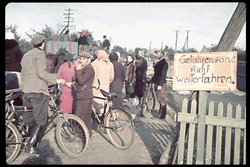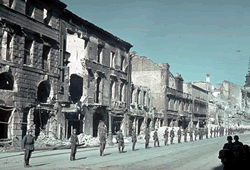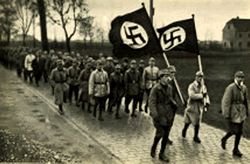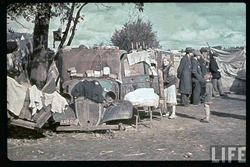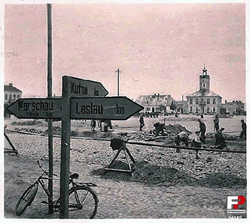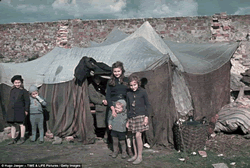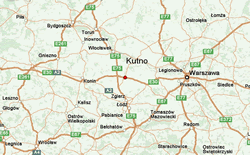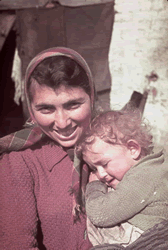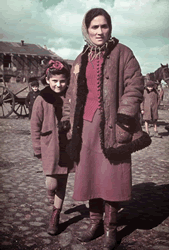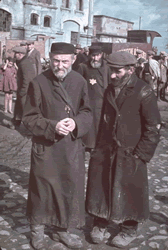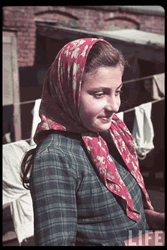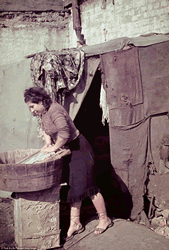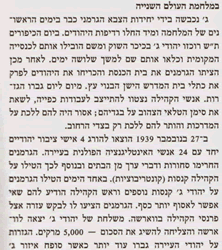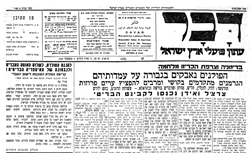The Invasion of Poland, 1939
Hugo Jaeger—The LIFE Picture Collection/Getty Images
Refugees near Warsaw during the 1939 German invasion of Poland. (Sign reads, 'Danger Zone -- Do Not Proceed.')
Burned-out tank, Warsaw, 1939.
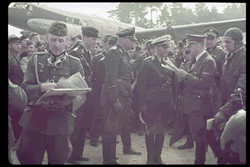
Adolf Hitler (right) prepares to fly to the Polish front, 1939.
Read more: Invasion of Poland, 1939: Color Photos From WWII’s First Front | LIFE.com http://life.time.com/history/world-war-ii-invasion-of-poland-1939-color-photos/#ixzz3CMZXJ4H2
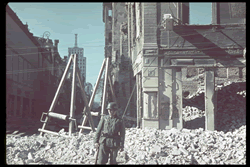
Hugo Jaeger—The LIFE Picture Collection/Getty Images
German troops prepare for victory parade after the invasion of Poland, 1939.
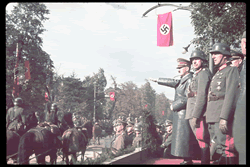
On Sept. 1, 1939, one week after Nazi Germany and the Soviet Union signed a non-aggression pact, more than a million German troops—along with 50,000 Slovakian soldiers—invaded Poland. Two weeks later, a half-million Russian troops attacked Poland from the east. After years of vague rumblings, explicit threats and open conjecture about the likelihood of a global conflict—in Europe, the Pacific and beyond—the Second World War had begun.
The ostensible aim of Germany’s unprovoked assault, as publicly stated by Hitler and other prominent Nazi officials, was the pursuit of lebensraum—that is, territory deemed necessary for the expansion and survival of the Reich. But, of course, Hitler had no intention of ending his aggression at Poland’s borders, and instead was launching a full-blown war against all of Europe. (On Sept. 3, both England and France declared war on Germany—but not on the USSR.)
The invasion—during which German troops, especially, drew virtually no distinction between civilians and military personnel and routinely attacked unarmed men, women and children—lasted just over a month. Caught between two massive, well-armed powers, the Polish army and its Air Force fought valiantly (contrary to legend, which has the Poles surrendering quickly, with barely a whimper). In the end, Poland’s soldiers and aviators, fighting on two fronts, were simply overwhelmed.
In the weeks and months after the invasion, a German photographer named Hugo Jaeger traveled extensively throughout the vanquished country, making color pictures of the chaos and destruction that the five-week battle left in its wake. Here, on the 75th anniversary of the start of World War II, LIFE.com presents a series of Jaeger’s pictures from Poland: portraits of a country subjugated not by one enemy, but by several.
In Jaeger’s photos, meanwhile, we see early, unsettling evidence of the violence, unprecedented in its scope, that would soon be visited upon scores of countries and countless people around the globe, from the streets of London and the forests of Belgium to the North African desert and the sun-scorched islands of the South Pacific.
_________________________
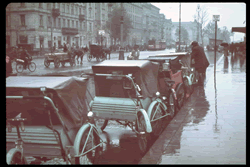
Read more: Invasion of Poland, 1939: Color Photos From WWII’s First Front | LIFE.com http://life.time.com/history/world-war-ii-invasion-of-poland-1939-color-photos/#ixzz3CMYWmADK?
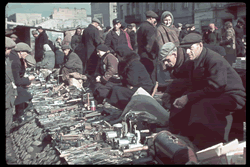
Warsaw 1940
Gostynin and Kutno
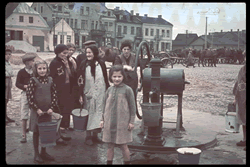
Jewish women and children in Gostynin, Poland, after the German invasion, 1939.
Read more: Invasion of Poland, 1939: Color Photos From WWII’s First Front | LIFE.com http://life.time.com/history/world-war-ii-invasion-of-poland-1939-color-photos/#ixzz3CMcYtIee
Gostynin (during the German occupation Waldrode (1940-1941, 1942-1945) and Gasten (1941-1942)) is a town in Central Poland with 19,414 inhabitants (2004). It is situated in the Masovian Voivodship since 1999 and was previously in the P?ock Voivodship from 1975 to 1998. It is the capital of Gostynin County.
Haunting smile of girl facing the Holocaust: How Hitler's PERSONAL photographer captured for history the plight of the Jews in Nazi-occupied Poland
• Hugo Jaeger's photographs normally celebrate the glory and triumphalism of the Third Reich
• But in this set he depicts the tragic circumstances of Jews while allowing them to retain their humanity and dignity
• Taken in the Polish town of Kutno in 1939 and 1940 they have been released to mark the official establishment of the Warsaw Ghetto
By Paul Harris
Published: 16:38 EST, 17 October 2012 | Updated: 01:41 EST, 19 October 2012
Read more: http://www.dailymail.co.uk/news/article-2219304/Haunting-smile-girl-facing-Holocaust-How-Hitlers-PERSONAL-photographer-captured-history-plight-Jews-Nazi-occupied-Poland.html#ixzz3CMV6HkHC
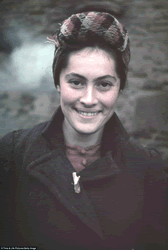
She has such natural beauty, she could pass for a movie star.
She smiles, her demeanour relaxed. In normal times, this young woman would surely have enjoyed a bright and happy future, perhaps with a husband, children, grandchildren.
But soon after this photograph was taken, she would face almost certain death. The haunting image is one of a series depicting Jews in Nazi-occupied Poland before they were rounded up to be sent to the gas chambers.
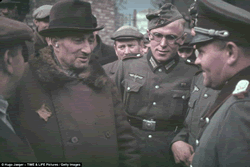
An elderly man with a yellow Star of David fixed to his chest, speaks with German officers as he and other Jews are rounded up in Kutno, German-occupied Poland in 1939
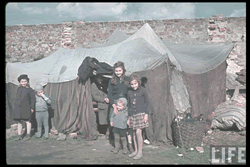
Innocent victims: These young Jewish girls couldn't possibly have imagined the horrors that lay ahead as they pose outside their tent in another haunting photograph taken by the ardent Nazi Hugo Jaeger
The clue is the curled-up piece of yellow cloth the unknown woman wears on her lapel – a makeshift Star of David.
All around her, and in other photos taken in the ghetto into which the Nazis corralled their prisoners, every man, woman and child was forced to wear one.
In peacetime, the six-pointed star was a proud symbol of Judaism. In the Holocaust which Hitler was about to unleash – here in the devastated town of Kutno – it would become their death-star.
More...
• Stash of mysterious 100-year-old photos discovered in hotel ceiling by workman carrying out renovations
• Doomsday goes designer as Florida survivalist store creates $60,000 bomb shelters complete with flat screen TVs
• A Fascist party in full cry. Black-shirts smashing migrants' homes. Swastikas on the streets. No, not Germany in the Thirties: Greece 2012
The remarkable colour images were taken by the Führer’s personal photographer, a loyal follower given unprecedented access to the Third Reich’s elite. Hugo Jaeger was allowed to travel with Hitler to record his appearances at rallies, intimate parties and in private moments. More usually he dedicated himself to lionising his leader and what the Nazis regarded as their most triumphant moments.
Here, it appears, he seems simply to have been fascinated by faces from a different faith in a country under siege. He is said not to have shared Hitler’s unqualified hatred of Jews. Hence, whether he intended it or not, Jaeger’s camera captured an atmosphere rarely seen before horror and carnage overtook it.
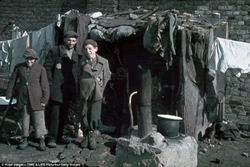
Ghetto boys: In their tattered rags the two boys smile for the camera, but the man in the centre, most probably their father, has a look of distrust etched across his face
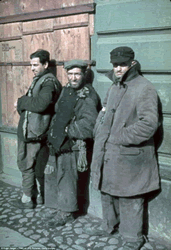
While most Jaeger's photographs focus on the glory and triumphalism of the Reich, here he has chosen instead to capture the misery of the conquered people instead

With their clean clothes and hair neatly coiffured, these three young women do not, at first glance, appear anything like Jaeger's other subjects. But look closer and you find a star of David on the coat of the girl on the left
After so many years, it is impossible to know for certain why so many people in the photographs are smiling. None appears to have been forced to pose, none seems to display any fear.
The trilby-hatted man in the coat with a fur collar, for example, seems quite comfortable in the company of German officers. Children in the squalor of a tented village appear unperturbed by the photographer. Yet Kutno, 75 miles west of Warsaw, had been bombarded and turned into a ghetto soon after Hitler’s invasion in September 1939.
Its sugar factory would be surrounded by barbed wire and used to imprison 8,000 Jews, crammed into appalling conditions.
Some would die of infection or starvation. Others would not live through the bitter cold of the winter.
The ghetto existed until 1942, when most of its surviving inhabitants were sent to death camps.
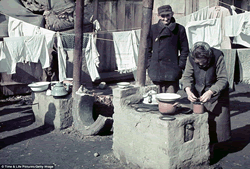
An elderly Jewish woman bends over her stove while a man, his Star of David badge clearly visible, watches over her in the Kutno Ghetto
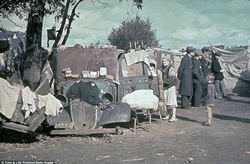
Makeshift dwelling: Jewish inhabitants of the Kutno Ghetto stand near a car which has been converted into a makeshift house in early 1940
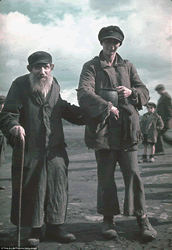
A young woman clutches a jug as she escorts an elderly Jewish man through the Kutno Ghetto in early 1940
It is highly unlikely any of the people in these images survived. Incredibly, the photographs did.
The Kutno ghetto was ‘liquidated’ as part of the Final Solution in the spring of 1942. In 1945, as the Allies advanced into Germany, Jaeger knew he would be arrested and tried as a war criminal if he was caught with so many intimate photos of the defeated Führer.
So after secreting them, initially in a leather suitcase, he buried them in airtight glass jars outside Munich, returning from time to time to check they were safe.
Two decades after the war ended, he sold them to Life magazine.
Now the pictures have gone online at Life.com. Despite attempts to identify some of the subjects, no record was ever found of the smiling young woman.
Historians said it would be astonishing if she had survived. At least the camera immortalised her.
The photos have been released to mark the official establishment of the Warsaw Ghetto in October 1940 and the entire set are on display at Life.com here.
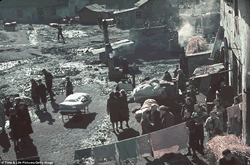
Daily life: An aerial view of the Kutno Ghetto which was set up on the grounds of a sugar factory
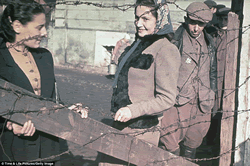
Follow us: @MailOnline on Twitter | DailyMail on Facebook
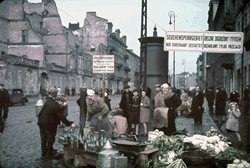
Hugo Jaeger—Time & Life Pictures/Getty Images
Warsaw, Nazi-occupied Poland, 1940. The signs read, "Typhus area. Passage permitted only while traveling."
History
1939
1940
In the late 1930s and early 1940s, a German photographer and ardent Nazi named Hugo Jaeger enjoyed unprecedented access to the Third Reich’s upper echelon, traveling with Adolf Hitler to massive rallies and photographing him at intimate parties and in quieter, private moments. The photos made such an impression on the Führer that Hitler famously declared, upon first seeing Jaeger’s work: “The future belongs to color photography.”
But beyond merely chronicling Hitler’s ceaseless travels, Jaeger also documented the brute machinery of the Reich, including the Nazi invasion of Poland in 1939. Here, LIFE.com presents a series of photos from Warsaw and from the town of Kutno, 75 miles west of the Polish capital, in 1939 and 1940. Adding perspective to the images is an essay (below) by Justyna Majewska, discussing just what Jaeger’s haunting images can still tell us about that era, three-quarters of a century after they were made. — Ben Cosgrove
_____________________________________________________________________________________________
Why would Hugo Jaeger, a photographer dedicated to lionizing Adolf Hitler and the “triumphs” of the Third Reich, choose to immortalize conquered Jews in Warsaw and Kutno (in central Poland) in such an uncharacteristic, intimate manner? Most German photographers working in the same era as Jaeger usually focused on the Wehrmacht; on Nazi leaders; and on the military victories the Reich was routinely enjoying in the earliest days of the Second World War. Those pictures frequently document brutal acts of humiliation, even as they glorify German troops.
The photographs that Jaeger made in the German ghettos in occupied Poland, on the other hand, convey almost nothing of the triumphalism seen in so many of his other photographs. Here, in fact, there is virtually no German military presence at all. We see the devastation in the landscape of the German invasion of Poland, but very little of the “master race” itself.
It is, of course, impossible to fully recreate exactly what Jaeger had in mind, but from the reactions of the people portrayed in these images in Warsaw and Kutno, there appears to be surprising little hostility between the photographer and his subjects. Most of the people in these pictures, Poles and Jews, are smiling at the camera. They trust Jaeger, and are as curious about this man with a camera as he is about them. In this curiosity, there is no sense of hatred. The men, women and children on the other side of the lens and Jaeger look upon one another without the aggression and tension characteristic of the relationship between perpetrator and victim.
[Read the stranger-than-fiction story of how Time Inc. came to own Hugo Jaeger's archive, and see more of his photos]
Strikingly, none of the people in these photos appear to have been forced to pose. In fact, Jaeger probably asked them for permission to take their pictures; maybe he and they had a short chat before he began photographing them. We can even go so far as to suggest that there is no sign of overt brutality here. To Jaeger (unlike for so many of the Reich’s supporters), Jews were not mere “rats,” or “parasites”: He simply perceived them as fascinating subjects. While he probably felt that their subjugation was inevitable in the face of the German Blitzkrieg, he nevertheless captures these already subjugated people sympathetically.
We know, all these decades later, that these thousands of people were, in fact, prisoners, whether or not the ghettos that would follow had already been built. [NOTE: In a city the size of Warsaw the creation of the notorious ghetto was quote complicated, and took a few months to complete; in Kutno, the Jews were forced into their ghetto in one day.]
We know what it means that their homes had been destroyed. We know what the anti-Semitic regulations—like the yellow Star of David that Jews were forced to wear at all times in public—would ultimately come to symbolize. But Jaeger, photographing in 1939, shows these people as a community trying to rebuild against all odds.
Seeing these photographs today, seven decades later, we know the harsh, unspeakable truth. Within a very short time, the situation for Kutno’s and Warsaw’s native Jews became more and more difficult, and ultimately catastrophic. Poles and Jews were separated from one another. The Nazis created a Jewish council, the Judenrat, responsible for making Jews obey the Germans’ diktats. The food supply dwindled horribly.
In June 1940, all of Kutno’s roughly 8,000 Jews were forced into the ghetto — the grounds of an old sugar factory. Typhus and hunger soon began killing hundreds of them. In 1942, the Nazis implemented Operation Reinhardt, which effectively put in motion the Nazi’s planned destruction of all Polish Jewry. In the spring of 1942 the Kutno Ghetto itself was “liquidated.” Jews who were unable to escape and find help among their Polish neighbors were taken to Kulmhof (Che?mno), the first death camp, located on the River Ner not far from the city of Lodz. There, thousands of Kutno’s Jewish men, women and children were put to death in “gas vans”—mobile gas chambers—in what were among the first mass murders of the Holocaust.
Operation Reinhardt also sealed the fate of the Jews of Warsaw. Liquidation of the Warsaw Ghetto started in July 1942 and took nearly three months to complete. Horrifically overcrowded cattle trains carried 300,000 Jews to Treblinka.
All these many years later, Jaeger’s pictures from Warsaw and Kutno are still so hard to look at—and hard to turn away from. I presume that the beautiful young girl seen smiling directly, confidently, at the camera (slide #1 in this gallery) is Jewish: on the collar of her coat, we see what is evidently a folded, yellow Star of David. Neither she, nor Jaeger himself, could have truly, fully foreseen her fate: to die of typhus, or to starve to death, or to be forced into a gas chamber at Chelmno, only to emerge again in a haunting photograph long, long after she was dead.
_______________________________________________________________________________________________
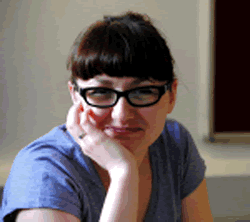
Justyna Majewska works as a curator at the Holocaust Gallery in the Museum of the History of Polish Jews in Warsaw. She is also a Ph.D. candidate in the Polish Academy of Science’s Institute of Philosophy and Sociology. Her dissertation focuses on social change in the Warsaw Ghetto.
Read more: World War II: Color Photos From Nazi-Occupied Poland, 1939 – 1940 | LIFE.com http://life.time.com/history/world-war-ii-color-photos-from-nazi-occupied-poland-1939-1940/#ixzz3CMX39at8
